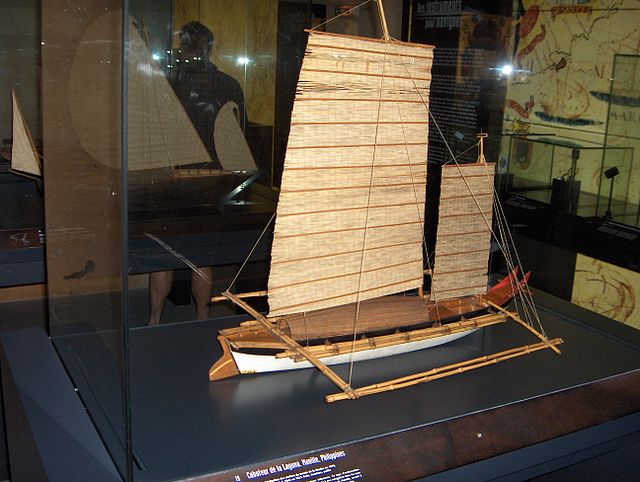The term bedar is applied to a wide variety of boats of the east coast of Malaysia that carry one or two junk sails and lack the typical transom stern of the perahu pinas. These junk rigged boats are usually built in the Terengganu area. The stern of the bedar is a classical "canu" or "pinky stern," being a typical "double ender", a bit like a modern ship's lifeboat, with a very full turn of the bilge and with markedly raked stem and stern. They came in small versions as small one-masted fishing vessels — anak bedar and were built as big as 90 feet over deck (LOD). The majority of the bedars were usually 45 to 60 feet over deck. The bedar, like all Terengganu boats, was built of Chengal wood by the Malays since the 19th century and roamed the South China Sea and adjacent oceans as a highly seaworthy traditional sailing vessel.
The original Naga Pelangi, a bedar built in 1981, sailing off Singapore
The last big sailing bedar, Dapat, (87' / 26.5 m LOD) anchored in Kuala Terengganu in 1980
The bedar Dapat unloaded in the estuary of Kuala Terengganu, 1980
Che Ali bin Ngah building the bedar Naga Pelangi on Pulau Duyong, Kuala Terengganu, 1981
The junk rig, also known as the Chinese lugsail, Chinese balanced lug sail, or sampan rig, is a type of sail rig in which rigid members, called battens, span the full width of the sail and extend the sail forward of the mast.
The Keying was a Chinese ship that employed a junk sailing rig.
Scale model of a Tagalog outrigger ship with junk sails from Manila, 19th century
A bronze mirror of Tang, Wudai, or Song era, shows a ship with a square sail. Shaanxi Provincial Museum, Xi'an.
A Southeast Asian ship with battened sails, Cambodia, 12–13th century CE.








